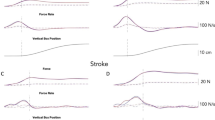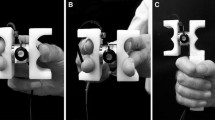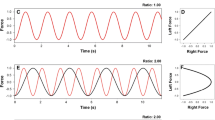Abstract
We investigated within- and between-hand grip and load force coordination in healthy young subjects during bimanual tasks involving realistic manual actions. Actions involving disparate actions of the two hands (bimanual asymmetry) were expected to result in lower overall measures of within- and between-hand measures of grip and load force coordination. As dissociation between two hands performing disparate actions may be expected, it was also hypothesized that increased task asymmetry would result in a shift toward higher within-hand force coordination. Features such as object rotation were found to reduce some, but not all indices of both within- and between-hand force coordination. The action of connecting two independent objects was associated with declines in all indices of within- and between-hand force coordination. Evidence of task-specific differences in force application timing and a trend toward within-hand grip-load coordination differences in the current data set suggest that individual hand specification emerges naturally in everyday bimanual prehension tasks, independent of the action role of the assigned to the dominant and non-dominant hands.




Similar content being viewed by others
References
Alberts JL, Tresilian JR, Stelmach GE (1998) The co-ordination and phasing of a bilateral prehension task. The influence of Parkinson’s disease. Brain 121:725–742. doi:10.1093/brain/121.4.725
Alberts JL, Saling M, Adler CH, Stelmach GE (2000) Disruptions in the reach-to-grasp actions of Parkinson’s patients. Exp Brain Res 134:353–362. doi:10.1007/s002210000468
Augurelle A-S, Smith AM, Lejeune T, Thonnard J-L (2003) Importance of cutaneous feedback in maintaining a secure grip during manipulation of hand-held objects. J Neurophysiol 89:665–671. doi:10.1152/jn.00249.2002
Blennerhassett JM, Carey LM, Matyas TA (2006) Grip force regulation during pinch grip lifts under somatosensory guidance: comparison between people with stroke and healthy controls. Arch Phys Med Rehabil 87:418–429
Dun S, Kaufmann RA, Li ZM (2007) Lower median nerve block impairs precision grip. J Electromyogr Kinesiol 17:348–354
Eastough D, Edwards MG (2006) Movement kinematics in prehension are affected by grasping objects of different mass. Exp Brain Res 176:193–198. doi:10.1007/s00221-006-0749-3
Fellows SJ, Noth J, Schwarz M (1998) Precision grip and Parkinson’s disease. Brain 121:1771–1784. doi:10.1093/brain/121.9.1771
Flanagan JR, Tresilian JR (1994) Grip-load force coupling: a general control strategy for transporting objects. J Exp Psychol Hum Percept Perform 20:944
Flanagan JR, Wing AM (1993) Modulation of grip force with load force during point-to-point arm movements. Exp Brain Res 95:131–143
Flanagan JR, Tresilian J, Wing AM (1993) Coupling of grip force and load force during arm movements with grasped objects. Neurosci Lett 152:53–56
Flanagan JR, Burstedt MK, Johansson RS (1999) Control of fingertip forces in multidigit manipulation. J Neurophysiol 81:1706
Freitas PB, Jaric S (2009) Force coordination in static manipulation tasks performed using standard and non-standard grasping techniques. Exp Brain Res 194:605–618. doi:10.1007/s00221-009-1738-0
Freitas PB Jr, Krishnan V, Jaric S (2007) Elaborate force coordination of precision grip could be generalized to bimanual grasping techniques. Neurosci Lett 412:179–184
Gorniak SL, Zatsiorsky VM, Latash ML (2007) Emerging and disappearing synergies in a hierarchically controlled system. Exp Brain Res 183:259–270. doi:10.1007/s00221-007-1042-9
Gorniak SL, Zatsiorsky VM, Latash ML (2008) Hierarchical control of static prehension: II. Multi-digit synergies. Exp Brain Res 194:1–15. doi:10.1007/s00221-008-1663-7
Gorniak SL, Zatsiorsky VM, Latash ML (2009) Manipulation of a fragile object. Exp Brain Res 202:413–430. doi:10.1007/s00221-009-2148-z
Gorniak SL, Zatsiorsky VM, Latash ML (2011) Manipulation of a fragile object by elderly individuals. Exp Brain Res 212:505–516. doi:10.1007/s00221-011-2755-3
Hermsdörfer J, Hagl E, Nowak DA, Marquardt C (2003) Grip force control during object manipulation in cerebral stroke. Clin Neurophysiol 114:915–929
Jackson G, German K, Peacock K (2002) Functional coupling between the limbs during bimanual reach-to-grasp movements. Hum Mov Sci 21:5–21. doi:10.1016/S0167-9457(02)00118-5
Jin X, Uygur M, Getchell N et al (2011) The effects of instruction and hand dominance on grip-to-load force coordination in manipulation tasks. Neurosci Lett 504:330–335. doi:10.1016/j.neulet.2011.09.059
Johansson RS, Westling G (1987) Signals in tactile afferents from the fingers eliciting adaptive motor responses during precision grip. Exp Brain Res 66:141–154
Kelso JS, Southard DL, Goodman D (1979) On the coordination of two-handed movements. J Exp Psychol Hum Percept Perform 5:229–238
Kinoshita H, Bäckström L, Flanagan JR, Johansson RS (1997) Tangential torque effects on the control of grip forces when holding objects with a precision grip. J Neurophysiol 78:1619–1630
Krishnan V, Jaric S (2010) Effects of task complexity on coordination of inter-limb and within-limb forces in static bimanual manipulation. Mot Control 14:528–544
Mason AH, Bruyn JL (2009) Manual asymmetries in bimanual prehension tasks: manipulation of object size and object distance. Hum Mov Sci 28:48–73
Mason AH, Bryden PJ (2007) Coordination and concurrency in bimanual rotation tasks when moving away from and toward the body. Exp Brain Res 183:541–556. doi:10.1007/s00221-007-1068-z
Obhi SS (2004) Bimanual coordination: an unbalanced field of research. Mot Control 8:111–120
Oldfield RC (1971) The assessment and analysis of handedness: the Edinburgh inventory. Neuropsychologia 9:97–113
Rice MS, Newell KM (2004) Upper-extremity interlimb coupling in persons with left hemiplegia due to stroke. Arch Phys Med Rehabil 85:629–634. doi:10.1016/j.apmr.2003.08.084
Sainburg R (2002) Evidence for a dynamic-dominance hypothesis of handedness. Exp Brain Res 142:241–258. doi:10.1007/s00221-001-0913-8
Sainburg RL (2005) Handedness: differential specializations for control of trajectory and position. Exerc Sport Sci Rev 33:206
Serrien DJ, Wiesendanger M (2001a) A higher-order mechanism overrules the automatic grip-load force constraint during bimanual asymmetrical movements. Behav Brain Res 118:153–160
Serrien DJ, Wiesendanger M (2001b) Dissociation of grip/load-force coupling during a bimanual manipulative assignment. Exp Brain Res 136:417–420. doi:10.1007/s002210000620
Serrien D, Steyvers M, Debaere F et al (2000) Bimanual coordination and limb-specific parameterization in patients with Parkinson’s disease. Neuropsychologia 38:1714–1722
Tresilian JR (1999) Abstract levels of motor control in prehension: normal and pathological performance. Hum Mov Sci 18:219–239
Weiss P, Jeannerod M (1998) Getting a grasp on coordination. Physiology 13:70–75
Westling G, Johansson RS (1984) Factors influencing the force control during precision grip. Exp Brain Res 53:277–284
White O, Dowling N, Bracewell RM, Diedrichsen J (2008) Hand interactions in rapid grip force adjustments are independent of object dynamics. J Neurophysiol 100:2738–2745. doi:10.1152/jn.90593.2008
Zhang W, Olafsdottir HB, Zatsiorsky VM, Latash ML (2009) Mechanical analysis and hierarchies of multi-digit synergies during accurate object rotation. Mot Control 13:251
Acknowledgments
This project was supported by NIH grant R01NS058706-01. We would like to thank Anil Thota, Jon Beno, and Osmysis (Cleveland, OH, USA) for their assistance in device and data collection design. We would also like to thank Ken Kula for his artistic contributions.
Author information
Authors and Affiliations
Corresponding author
Rights and permissions
About this article
Cite this article
Gorniak, S.L., Alberts, J.L. Effects of task complexity on grip-to-load coordination in bimanual actions. Exp Brain Res 225, 559–567 (2013). https://doi.org/10.1007/s00221-012-3395-y
Received:
Accepted:
Published:
Issue Date:
DOI: https://doi.org/10.1007/s00221-012-3395-y




